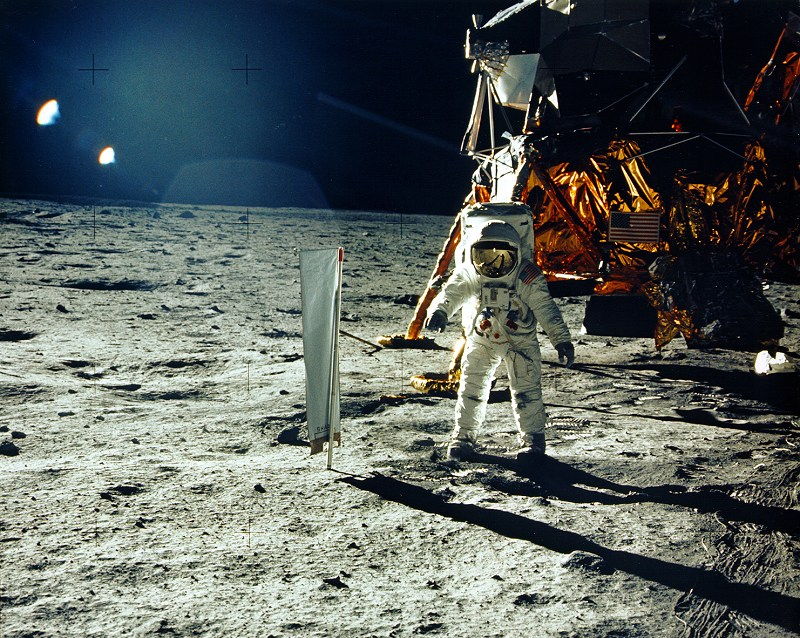Apollo 11 Flight Log, July 20, 1969: The Moon Landing
Click unmute on the video above hear mission audio from Flight Day 4 - Moon Landing Day - of the Apollo 11 mission and listen to over 50 minutes of audio in the video from NASA below.
This summer marks the 50th anniversary of NASA’s Apollo 11 mission. Fifty years ago today (July 20), astronaut Michael Collins orbited the moon in the command and service module as his crew members Neil Armstrong and Buzz Aldrin stepped onto the moon, cementing an incredible first for human history. Here's how it happened.
Lunar landing operations for the Apollo 11 crew officially began around 9:27 a.m. July 20, when lunar module pilot Buzz Aldrin crawled through a tunnel separating the command module Columbia from the lunar module, Eagle, to power on the lander.
- Relive the Apollo 11 Moon Landing Mission in Real Time
- Apollo 11 at 50: A Complete Guide to the Historic Moon Landing
- Apollo 11 Moon Landing Giveaway with Simulation Curriculum & Celestron!
Four hours later, Buzz Aldrin and his commander, Neil Armstrong, stood in Eagle while it separated from Columbia. At the controls of Columbia, command module pilot Michael Collins turned on the ship's engines and moved it away. He watched as Armstrong and Aldrin fired Eagle's engines for the lunar descent. "Everything's going just swimmingly. Beautiful!" Collins said over radio to Mission Control.
But not everything went to plan after that. Eagle's computer experienced several task overloads that tripped program alarms in the spacecraft. Just after 4 p.m., Armstrong looked outside the window and saw the automatic landing system was taking Eagle to a rocky field. He took control of the spacecraft, steering it down to the surface with just seconds of fuel to spare. Apollo 11 was on the moon.
"Houston, Tranquility Base here. The Eagle has landed," he radioed Mission Control at 4:18 p.m.
The main event, the moonwalk, began at 10:39 p.m. when Armstrong opened the hatch of Eagle and backed outside, watched by Aldrin. He carefully moved down the ladder, turning on the TV camera on the way. His first step took place at 10:56 p.m. "That's one small step for [a] man, one giant leap for mankind," he radioed Earth.
Breaking space news, the latest updates on rocket launches, skywatching events and more!
NASA's Historic Apollo 11 Moon Landing in Pictures
Armstrong quickly moved to take samples from nearby Eagle, and Aldrin followed him on to the surface. The moonwalk lasted 2.5 hours, in which time the men picked up several rock samples, deployed science experiments, erected a flag and took a phone call from U.S. President Richard Nixon. Eagle's hatch was closed, astronauts inside, at 1:11 a.m. the next morning.
Editor's note: This feature, originally posted in 2014, has been updated for the 50th anniversary of the Apollo 11 mission. Space.com contributor Chelsea Gohd contributed to this report.
Follow Elizabeth Howell @howellspace, or Space.com @Spacedotcom. We're also on Facebook and Google+.

Elizabeth Howell (she/her), Ph.D., was a staff writer in the spaceflight channel between 2022 and 2024 specializing in Canadian space news. She was contributing writer for Space.com for 10 years from 2012 to 2024. Elizabeth's reporting includes multiple exclusives with the White House, leading world coverage about a lost-and-found space tomato on the International Space Station, witnessing five human spaceflight launches on two continents, flying parabolic, working inside a spacesuit, and participating in a simulated Mars mission. Her latest book, "Why Am I Taller?" (ECW Press, 2022) is co-written with astronaut Dave Williams.

